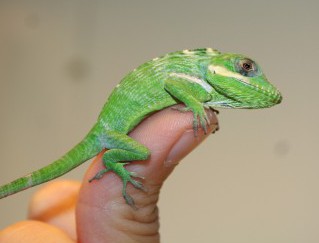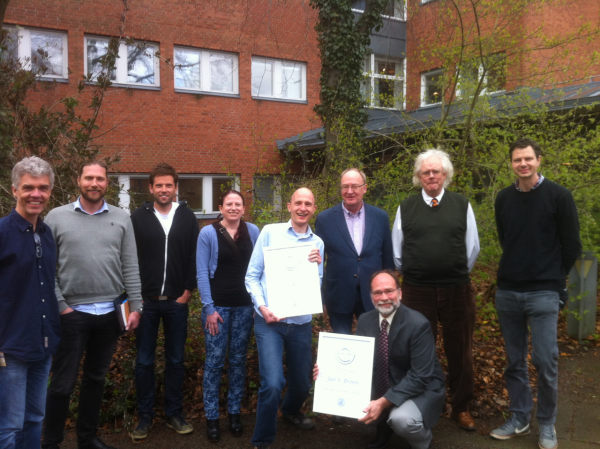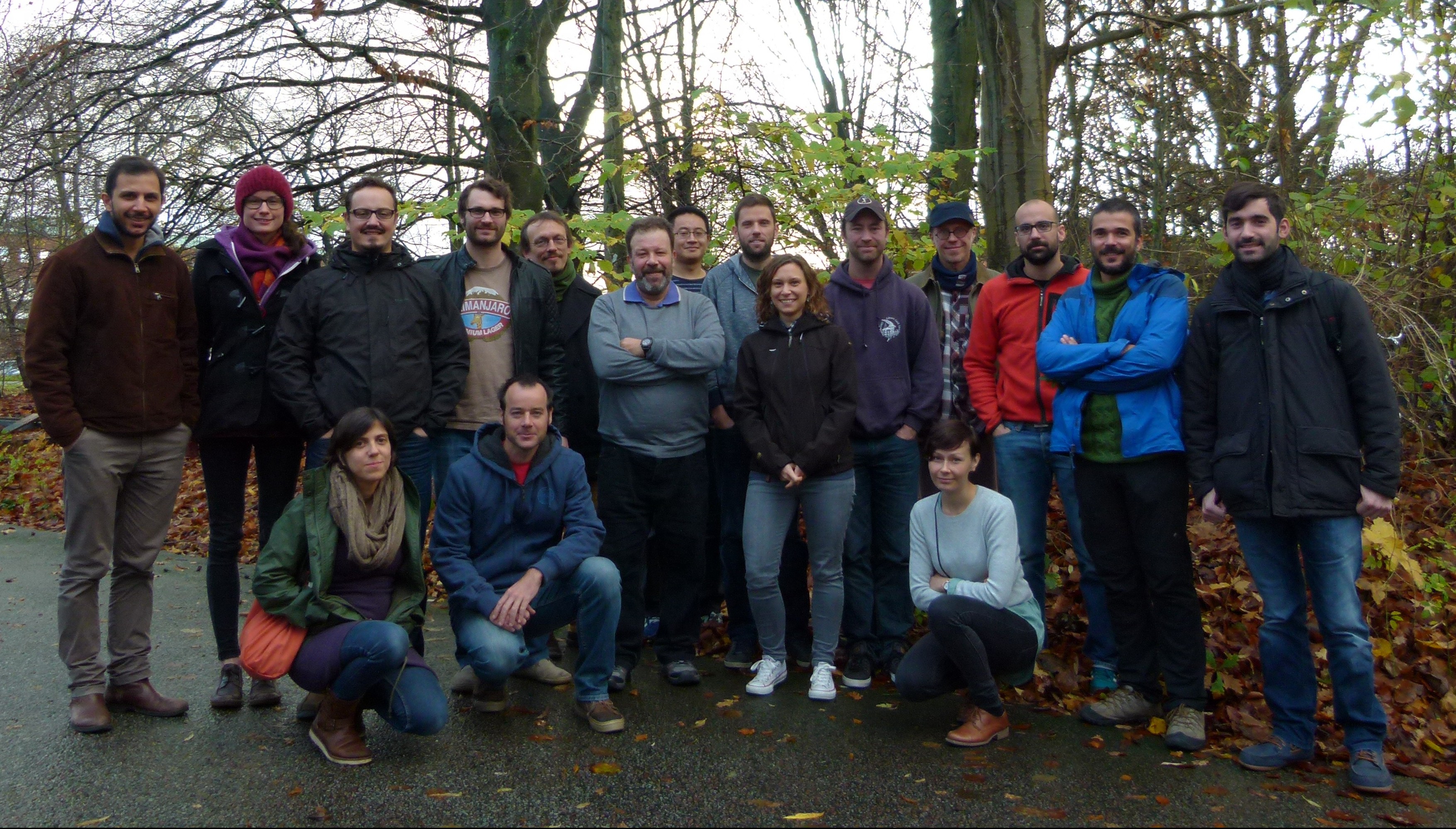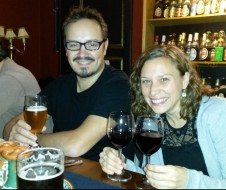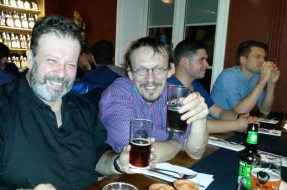8th World Congress of Herpetology in Hangzhou, China
The World Congress of Herpetology (WCH) is held every four years, and this time it was planned to take place in Hangzhou, China, from August 15-20, 2016. However, unforeseen circumstances related to the G20 summit held in Hangzhou just 2 weeks later forced the organising committee to change plans and move the venue to the small city of Tonglu, 100 km south of Hangzhou. Within only two days on hand, the local organizers nevertheless managed to transfer all 650 participants to Tonglu and arrange a new venue, a truly impressive achievement!
After this slightly bumpy start, the congress was held as scheduled and the participants could get back to science. As expected for a taxonomic meeting, the topics ranged far and afield – from conservation biology to biogeography, systematics, evolution, genomics and ethnoherpetology. The WCH traditionally does not feature much research on developmental biology, despite the fact that amphibians and reptiles have figured very prominently in comparative embryology and developmental mechanics during the first half of the 20th century. Therefore, Tobias and Nathalie decided to organise a symposium entitled ‘Ontogeny Creates Phylogeny – How Can a Developmental Approach Contribute to Herpetology?’.
T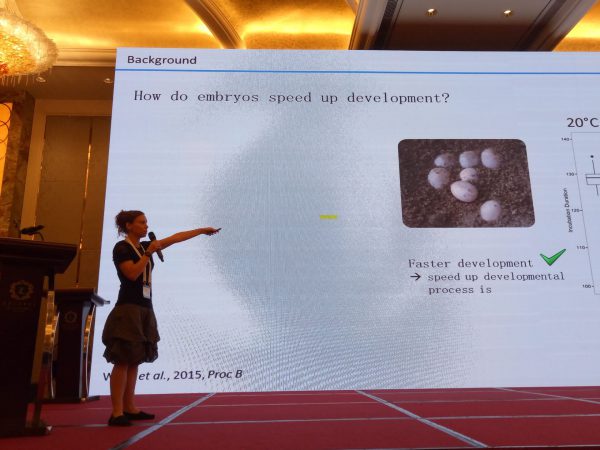 he symposium was held in the ‘Grand Imperial Ball Room’, the main hall of the venue. Despite that participants could choose from six parallel sessions, our symposium drew a large crowd. The speakers of the symposium had the opportunity (or challenge) to present their research to a broad audience that is not specialized in developmental biology. Amongst a great line-up of speakers, including Prof. Jim Hanken and Prof. Mike Richardson, Nathalie presented our developmental genetics work showing how wall lizards have adapted to low incubation temperatures in England.
he symposium was held in the ‘Grand Imperial Ball Room’, the main hall of the venue. Despite that participants could choose from six parallel sessions, our symposium drew a large crowd. The speakers of the symposium had the opportunity (or challenge) to present their research to a broad audience that is not specialized in developmental biology. Amongst a great line-up of speakers, including Prof. Jim Hanken and Prof. Mike Richardson, Nathalie presented our developmental genetics work showing how wall lizards have adapted to low incubation temperatures in England.
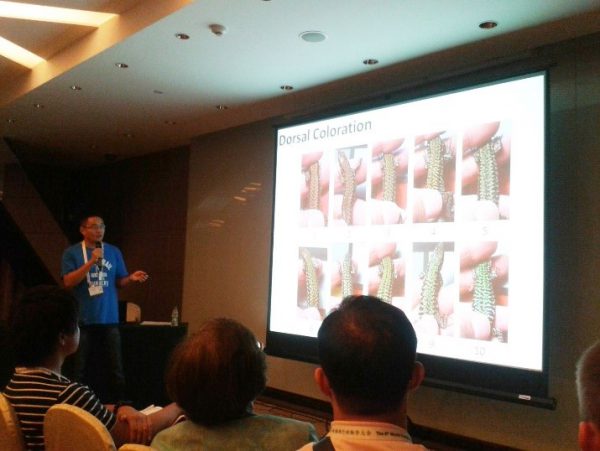 One of the most popular symposia was the one on hybrid zones organised by Ben Wielstra & Evan McCartney‐Melstad. Here, Yang gave the audience a flavour of the genomics of the sexually selected introgression between French and Italian wall lizards. This symposium nicely demonstrated that genomic analyses of hybridization have become a hugely prolific research area. High numbers of samples can be sequenced, which allows a detailed reconstruction of historical processes and testing hypothesis about what drives genetic exchange.
One of the most popular symposia was the one on hybrid zones organised by Ben Wielstra & Evan McCartney‐Melstad. Here, Yang gave the audience a flavour of the genomics of the sexually selected introgression between French and Italian wall lizards. This symposium nicely demonstrated that genomic analyses of hybridization have become a hugely prolific research area. High numbers of samples can be sequenced, which allows a detailed reconstruction of historical processes and testing hypothesis about what drives genetic exchange.
All in all, the WCH was scientifically and culturally (for Nathalie, not so much for Yang) a very interesting experience and a nice way of getting to know the herp communities around the world. Maybe the Uller group will have even more to deliver at the next WCH held in New Zealand in 2020!
![]()
English wall lizards look inbred
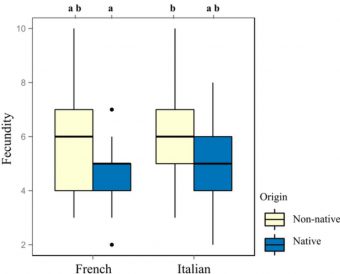 Our new paper in Molecular Ecology makes use of 21 introductions of wall lizards into England to show how founder history affects the loss of genetic diversity. We also show that early embryonic mortality is very high in non-native populations compared to native ones.
Our new paper in Molecular Ecology makes use of 21 introductions of wall lizards into England to show how founder history affects the loss of genetic diversity. We also show that early embryonic mortality is very high in non-native populations compared to native ones.
This looks very much like inbreeding depression, but not all populations or individuals that are inbred do poorly. So there’s different interesting things going on and it could be an interesting system to study in more genomic detail.
![]()
Euro Evo Devo meeting in Uppsala
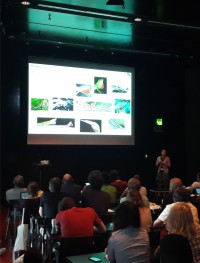
Nathalie giving her talk
The group was well represented at the 2016 Euro Evo Devo meeting in a beautiful and sunny Uppsala. Nathalie gave a talk on the role of transposable elements in the Anolis lizard radiation, and Antonio presented results from his PhD thesis, which reveal how some turtles evolved the ability to withdraw their heads into the shell. Both talks were great and stimulated a lot of discussion.
Nathalie and Antonio also organised a fantastic symposium on plasticity and evolution, with Arkhat Abzhanov and Armin Moczek among the speakers. Definitely one of the highlights of the meeting! Tobias did not really contribute anything, but he made some new friends and learnt a lot in symposia and at the pub.
Thanks to Graham Budd and his team for great organisation and entertainment!
![]()
Summer Lab News in Brief
The Mediterranean Lizards meeting this year was held in Limassol, Cyprus. Tobias gave one of the plenaries, covering our ongoing study of the causes and consequences of hybridization in wall lizards. Sozos presented his recent Molecular Ecology paper on genetic diversity and inbreeding depression in non-native lizard populations in England, and Nathalie explained the developmental genetics of how wall lizard embryos have adapted to the cold climate they encounter on the British Isles.
Back in Lund the Anolis baby boom continues. With twelve species breeding, Nathalie and Hanna are busier than ever feeding, checking for eggs, and taking measurements. Up in the Pyrenees, Antonio and Bea have discovered what must be one of the best views from any field station, and in the Daphnia room Reinder and Alex are following the fate of hundreds of water fleas trying to understand how mothers make their kids locally adapted… And Yang? Well, he just got the wall lizard sequence data back so I guess we will not see him in a while!
![]()
Congrats Prof. Tobias
Tobias has been promoted to Professor of Evolutionary Biology! The whole group congratulates Tobias for reaching this milestone, we know you are just in the beginning of an excellent career :-)!
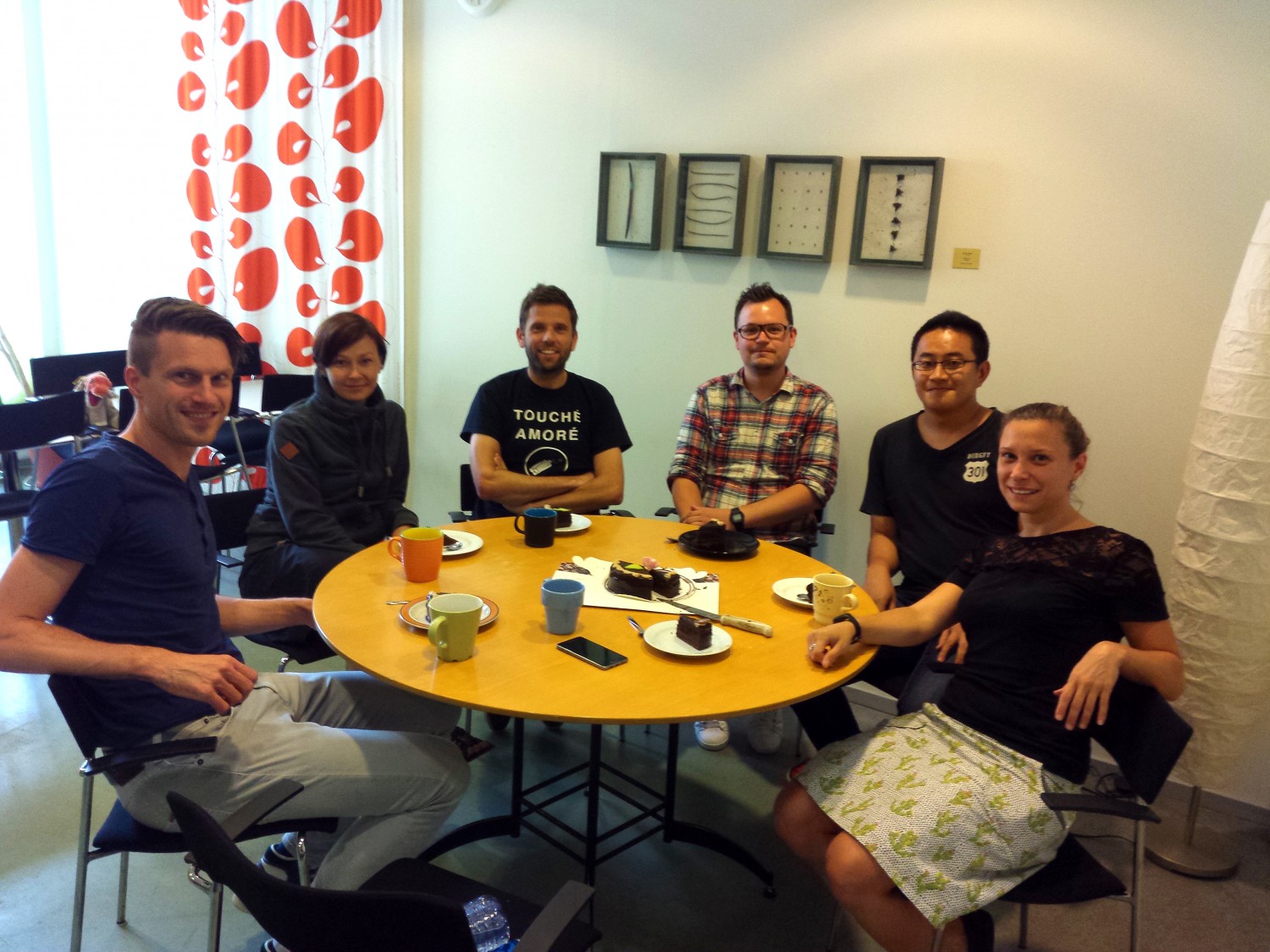
Some cake to celebrate…
![]()
Open PhD position
Are you interested in the relationship between developmental plasticity, maternal effects and evolution? If you also have a strong interest in evolutionary theory and a background in ecology you should consider applying. The details on the position and how to apply can be found here. For informal inquiries, please email Tobias.
![]()
The 3rd Golden PEG meeting
The Golden PEG is a biannual event at Lund University to celebrate research in ecology and evolution. From lifetime achievement awardee Joel Brown at UI Chicago we learnt how evolutionary ecology can help us battle cancer. Joel’s work is an excellent example of how to constructive it can be to apply evolutionary perspectives to medicine. The Up-and-Coming award went to Bram Kuijper from the University of Exeter and UCL. Bram’s talk nicely illustrated his models of how maternal effects can influence adaptation to novel environments. Our guest of honour, Olof Leimar from Stockholm University, put Joel’s and Bram’s research in perspective and the rest of the day was filled with talks by LU biologists. A very stimulating day was rounded off with an excellent, and fun, dinner at Mat & Destillat. Thanks to Per, Jörgen and the rest of the organisers for a great meeting!
Speakers and organizers of the Golden PEG Symposium.
![]()
Italy field work completed!
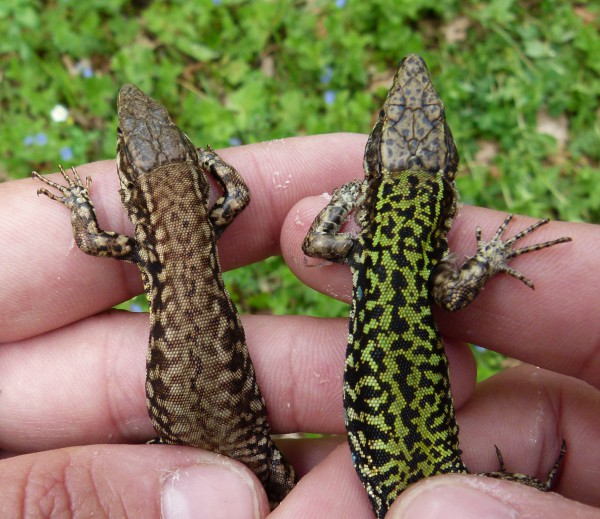 Now on its fifth year, the spring field trip to Italy surely counts as a tradition. But for Hanna and Yang it was the first one. Finally they got to see where all those DNA samples come from! This year we were also very much helped by the knowledge and skills of the Italian colleagues. Daniele Salvi joined our sampling team for several days, and his local knowledge of lizards around Rome and expert catching skills made us more efficient than ever.
Now on its fifth year, the spring field trip to Italy surely counts as a tradition. But for Hanna and Yang it was the first one. Finally they got to see where all those DNA samples come from! This year we were also very much helped by the knowledge and skills of the Italian colleagues. Daniele Salvi joined our sampling team for several days, and his local knowledge of lizards around Rome and expert catching skills made us more efficient than ever.
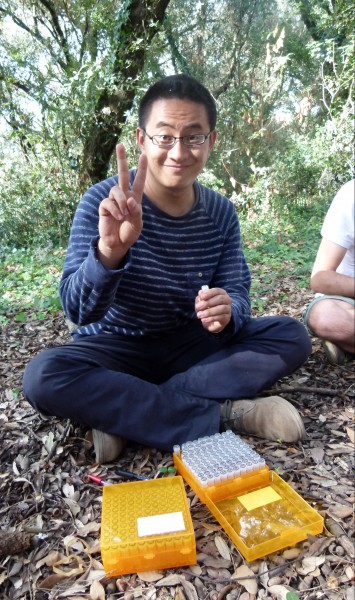 Despite some bad weather towards the end of the trip, we completed two new transects across hybrid zones between our green-and-black Tuscan lizards and the brown guys. Judging from the phenotypes, the patterns of introgression are very similar to what we see in the Liguria hybrid zone. It will be very interesting to see if this similarity extends to the genome.
Despite some bad weather towards the end of the trip, we completed two new transects across hybrid zones between our green-and-black Tuscan lizards and the brown guys. Judging from the phenotypes, the patterns of introgression are very similar to what we see in the Liguria hybrid zone. It will be very interesting to see if this similarity extends to the genome.
The curse of phylogeography is that every time you put another dot on the map it creates a new gap between dots… Being in the field also stimulated ideas, so we have plenty of good reasons to be back again next year, armed with new results.
Left: Yang collected lots of data for future analyses
Below: Sampling on an ancient aqueduct in Rome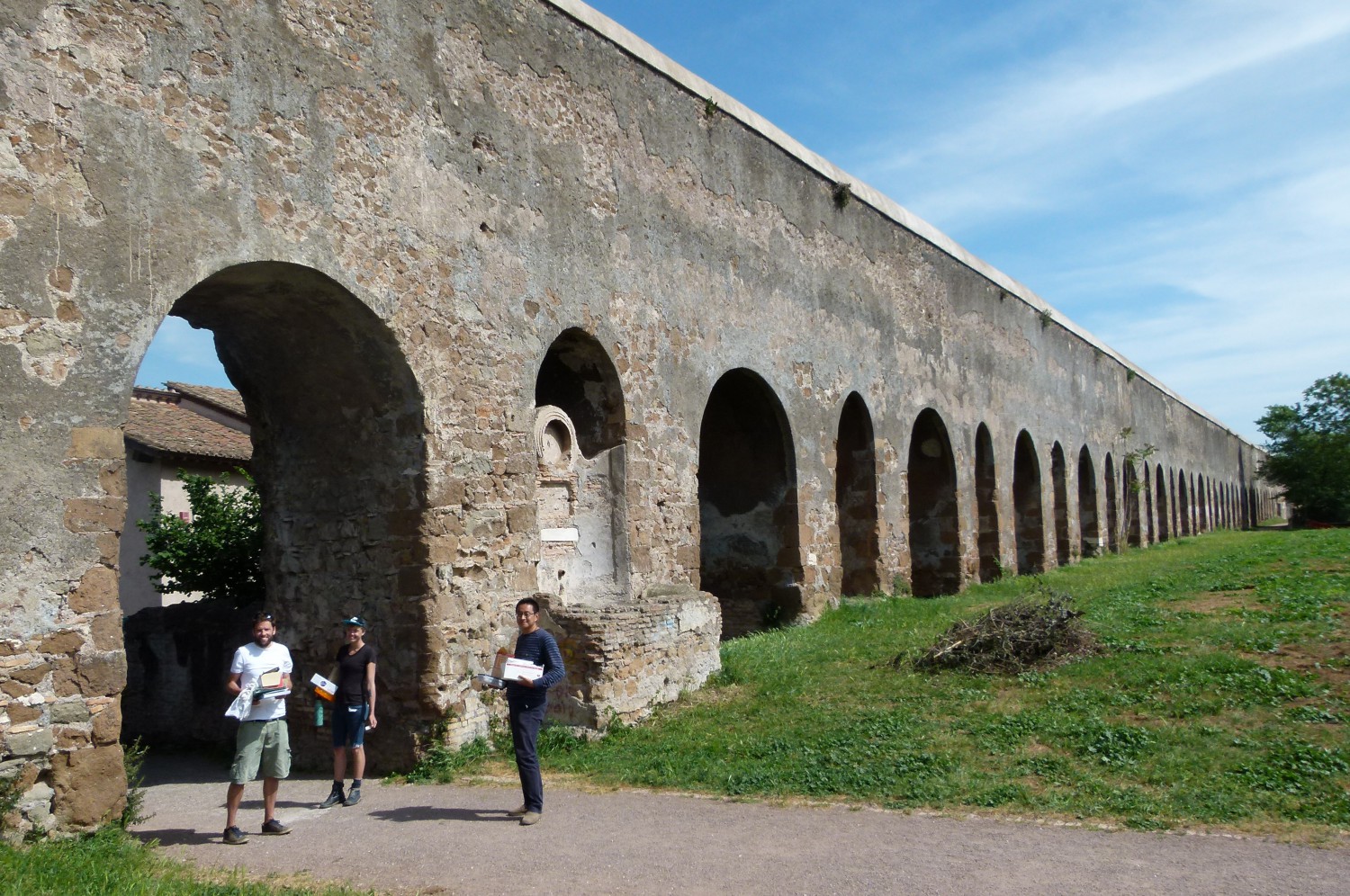
Below: We visited Marco Zuffi and the Mi.Pi.Pa team in Calci, where we received a full tour to the zoological museum and planned our sampling schemes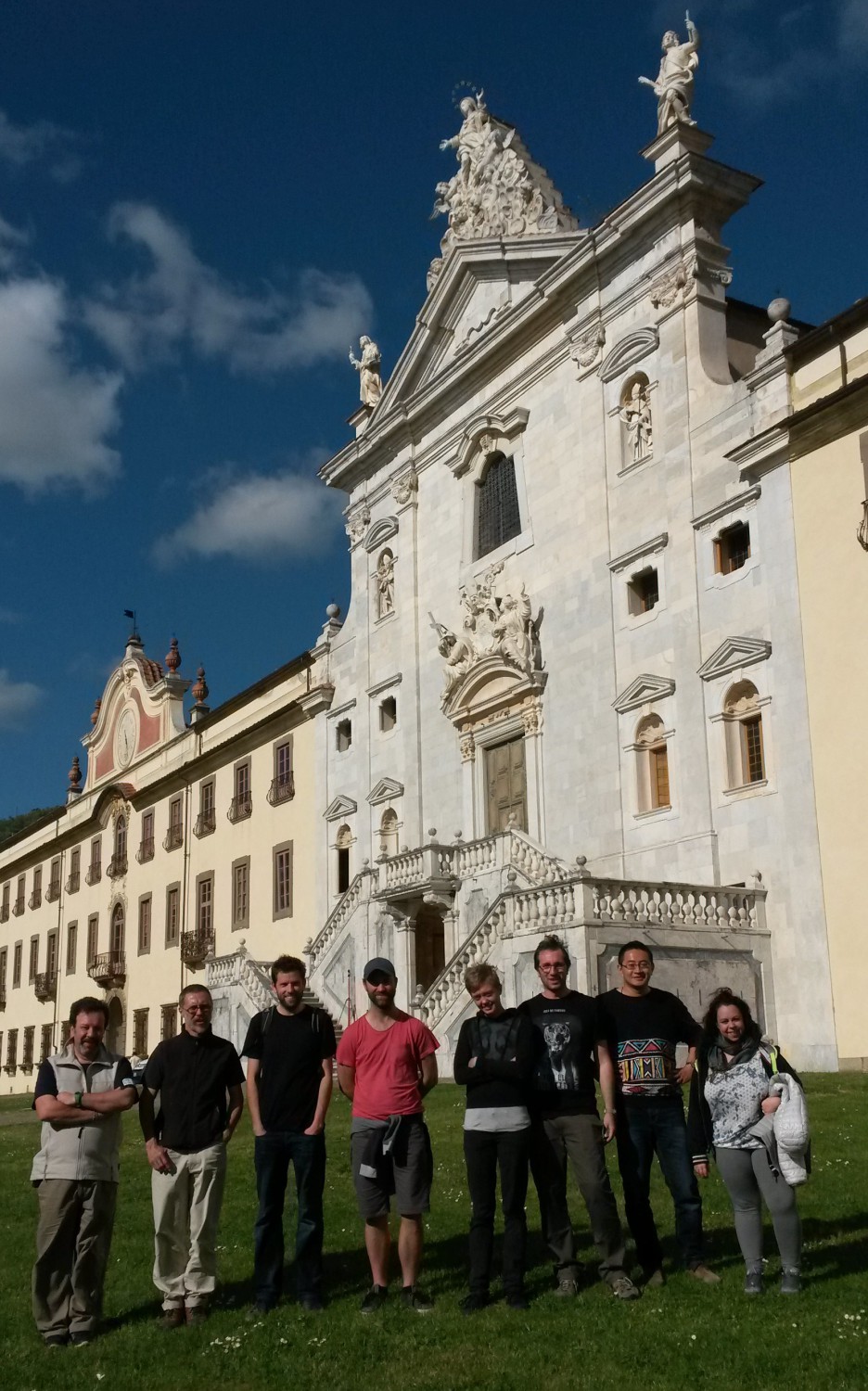
![]()
Major research funding!
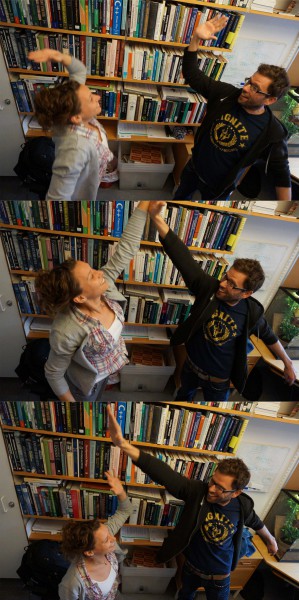 Good News!! Tobias Uller and Kevin Laland have received a £5.7 million grant from the John Templeton Foundation. The project brings together an international multi-disciplinary team of 50 world-renowned experts centered at eight institutions. The aim is to study evolution with alternative perspectives on the relationships between genes, organism, and environment. Tobias is the Project Co-Leader, making Lund University one of the main beneficiaries and a centre for the initiative.
Good News!! Tobias Uller and Kevin Laland have received a £5.7 million grant from the John Templeton Foundation. The project brings together an international multi-disciplinary team of 50 world-renowned experts centered at eight institutions. The aim is to study evolution with alternative perspectives on the relationships between genes, organism, and environment. Tobias is the Project Co-Leader, making Lund University one of the main beneficiaries and a centre for the initiative.
What are these alternative perspectives that people talk about? Well, the brief answer is that – in contrast to how biologists typically think about biological causation – the genome does not have privileged control over development and heredity. Instead, the organism plays active, constructive roles in its own development as well as that of its descendants. Once biological causation is viewed this way, it becomes apparent that developmental bias, plasticity, niche construction and so on gives a directionality to evolution that is not very well accounted for by natural selection of genetic variation alone (you can read the details about what has become known as the ‘extended evolutionary synthesis’ here in the 2015 Darwin Review in Proc R Soc Lond B).
Project Leader Professor Kevin Laland at the University of St Andrews says:
“The extended evolutionary synthesis does not replace traditional thinking, but rather can be deployed alongside it to stimulate research within evolutionary biology. The new perspective retains the fundaments of evolutionary theory – genes and natural selection remain central, for instance – but there are differences in how causation in biology is understood. As a result, some of the burden of explanation for adaptation and the diversity of life forms falls on the constructive processes of development” (for more, see this interview with Kevin on This View of Life).
The grant is one of the largest to ever be awarded to evolutionary research and funds 22 inter-linked projects under four umbrella themes. It also supports a wide range of additional activities that will promote interaction and collaboration between institutions in Sweden, Great Britain, and the USA. Institutional contributions to salaries and studentships amount to a further £2.0 million that support the research and the education and training of doctoral students.
A unique feature of the research programme is that the scientists team up with leading philosophers of science to advance our understanding of evolution.
“The central involvement of philosophers of science will bring increased awareness among biologists of how conceptual frameworks shape their own research. This will leave us better equipped to overcome communication barriers and differences in perspective, and ultimately facilitate scientific progress” says Dr Uller.
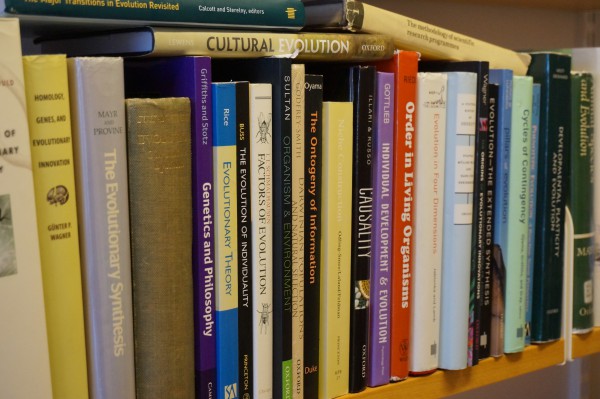 The guiding principles for the 22 projects have therefore been to identify conceptual differences between traditional and alternative interpretations of the evolutionary process, develop theory that fills the gaps in contemporary understanding, and to devise key projects that provide critical tests of points of contention.
The guiding principles for the 22 projects have therefore been to identify conceptual differences between traditional and alternative interpretations of the evolutionary process, develop theory that fills the gaps in contemporary understanding, and to devise key projects that provide critical tests of points of contention.
“New views on development and heredity require new models of evolution” says Stanford University theoretical biologist Professor Marcus Feldman, a Member of the US National Academy of Science, whose projects focus on the evolutionary implications of non-genetic inheritance.
One innovative approach is to make use of learning theory to understand how and why biological systems can be so good at evolving, a project headed by Dr Richard Watson at the University of Southampton (work recently featured in New Scientist).
“I am very excited to be part of this initiative, which promises to not only advance our understanding of how evolution works, but also help to better connect evolutionary biology to other disciplines” says Professor Paul Brakefield, a Fellow of the Royal Society of London at the University of Cambridge, another of the participating universities.
The three remaining institutions funded by the John Templeton Foundation are Indiana University, Clark University and the Santa Fe Institute.
Here at Lund University, the project involves Tobias and Nathalie Feiner from the Uller group, Wallenberg Academy Fellow Dr Charlie Cornwallis, Professor Erik Svensson, and Professor Per Lundberg. Lund clearly is a good place to be for those interested in links between development, ecology and evolution. We also hope to inspire biologists to look towards philosophy of science for insights that keep us alert and better able to understand what it is that we are actually doing. Postdoctoral opportunities to join the research program will be advertised soon at ullergroup.se and through the usual channels. If you are interested in our work and would like to come on your own funding please do not hesitate to get in touch.
![]()
Field season starts! First to Florida…
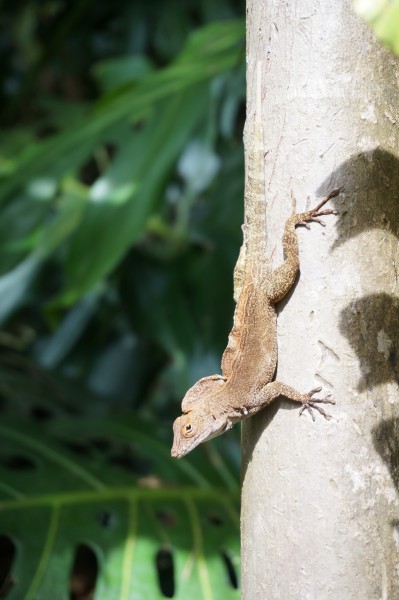 Nathalie started the field season 2016 with an 8-day trip to Florida for her project on the evolution of limb development in Anolis lizards. After doing lab-based Anolis research for almost three years, it was about time to meet these fascinating lizards in the wild! Ten (!) Anolis species have been introduced to Florida from the Caribbean islands, which makes it a hotspot for convenient field work. Since Nathalie was a novice at Anolis catching, she joined Dan Warner and his research group (University of Auburn) at their Palm Coast field site. Besides getting help with her own project,
Nathalie started the field season 2016 with an 8-day trip to Florida for her project on the evolution of limb development in Anolis lizards. After doing lab-based Anolis research for almost three years, it was about time to meet these fascinating lizards in the wild! Ten (!) Anolis species have been introduced to Florida from the Caribbean islands, which makes it a hotspot for convenient field work. Since Nathalie was a novice at Anolis catching, she joined Dan Warner and his research group (University of Auburn) at their Palm Coast field site. Besides getting help with her own project, 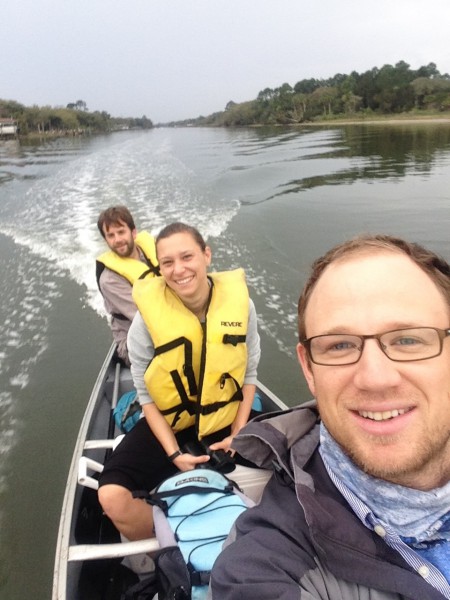 she joined Dan’s team in their research on brown anoles on islands in the Matanzas River. The Warner lab has several exciting projects on phenotypic plasticity and how maternal effects can help offspring cope with particular environments. The brown anole is perfectly suited for these questions since they are incredibly abundant on the islands and several hundred individuals can be caught within a day. Bob Cox and his students (University of Virginia) also joined the rental house for the last few days so Nathalie was spoiled to be surrounded by other Anolis enthusiasts.
she joined Dan’s team in their research on brown anoles on islands in the Matanzas River. The Warner lab has several exciting projects on phenotypic plasticity and how maternal effects can help offspring cope with particular environments. The brown anole is perfectly suited for these questions since they are incredibly abundant on the islands and several hundred individuals can be caught within a day. Bob Cox and his students (University of Virginia) also joined the rental house for the last few days so Nathalie was spoiled to be surrounded by other Anolis enthusiasts.
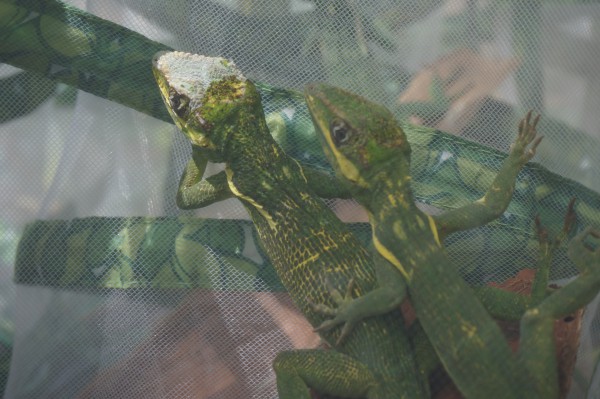 Her trip ended with a tour of the Fairchild Tropical Botanical Garden in Miami, where researcher James Stroud introduced her to the quite unusual lizard communities one can find in Florida, including 5 different Anolis species (only one is native), Red-headed agama, Green iguana, Brown basilisk and several gecko species. This was a nice end to a very enjoyable first experience of wild Anolis. Now the breeding season may start!
Her trip ended with a tour of the Fairchild Tropical Botanical Garden in Miami, where researcher James Stroud introduced her to the quite unusual lizard communities one can find in Florida, including 5 different Anolis species (only one is native), Red-headed agama, Green iguana, Brown basilisk and several gecko species. This was a nice end to a very enjoyable first experience of wild Anolis. Now the breeding season may start!
![]()
Fieldwork in Australia
Tobias and Nathalie have spent the last three weeks in the field in Australia working on an ARC funded project on the evolution of social complexity in lizards. The project is a collaboration led by Geoff While at the University of Tasmania, which also involves Charlie Cornwallis in Lund and several research groups in Australia.
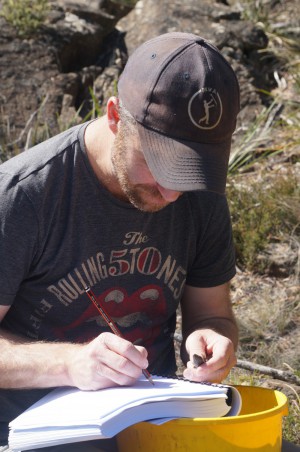
Geoff measuring lizards
Our aim is to understand early transitions to family life. Most lizards have limited interactions with close kin, but in the Egernia group some species form lasting pair bonds and have offspring that stay at home. In the most extreme cases this leads to multiple overlapping generations and large communities of more or less related individuals that share dwellings, often complex systems of crevices or burrows, which are inherited down generations. This quick guide in Current Biology covers the basics.
A great advantage of Egernia is that we can address the causes of variation in social complexity at three different levels – within populations, among populations, and among species. On this trip we have visited some study sites and species that were new to us. Outside Albury Julia Riley showed us the study site for her PhD project on tree skinks (Egernia striolata), supervised by Martin Whiting and Dan Noble. In the Australian Alps we were given a tour of Guthega skink (Liopholis guthega) sites by Zak Atkins. Guthega skinks are only found in a few high elevation (>1600 m) sites. Zak’s project, which is supervised by Kylie Robert in collaboration with David Chapple, provides important data for comparative analyses of the causes of social complexity in Egernia. He is also revealing some very interesting aspects of the species’ thermal biology, among other things.
 Guthega skinks live in the high country
Guthega skinks live in the high country
The last two weeks were spent lecturing at the University of Tasmania and field working in the eastern and south-western parts of the state. It is on Tasmania we find the main study species, White’s skink (Liopholis whitii). We – or rather Geoff and his students – make use of field, enclosure, and laboratory experiments to understand the evolutionary causes and consequences of social complexity. Although it was too hot for skinks at times, we caught a lot of lizards and had many good nature experiences, including close encounters with penguins.
Hanna is now Dr Hanna Laakkonen!
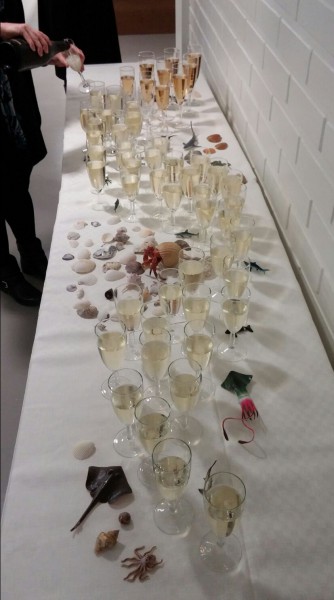 With expected ease and elegance Hanna defended her PhD thesis at the University of Helsinki on November 27, followed by a traditional Finnish party.
With expected ease and elegance Hanna defended her PhD thesis at the University of Helsinki on November 27, followed by a traditional Finnish party.
In her thesis, Hanna used molecular markers to establish the extent to which fish and invertebrate fauna of the Northern Pacific and Atlantic Oceans have exchanged genetic material. These data reveal a remarkable variation among taxa and in 30% of case studies could she establish more than one trans-Arctic invasion. Hanna’s work is a massive effort that synthesizes data from more than 70 taxa and shows that animal movement in this part of the world has been more dynamic than previously believed. Most chapters are published but the thesis itself can be found here. Many congratulations, Hanna!
Congratulations Dr. Sozos Michaelides!
Sozos Michaelides successfully defended his DPhil thesis on Nov 20th at the University of Oxford. A clean pass without corrections! The external examiner Dr Jason Kolbe from Rhode Island University made the viva both challenging and fun – just like it should be. Celebrations continued well into the Oxford night with many familiar faces from the EGI and the Department of Zoology showing up to celebrate Dr Sozos.
Sozos’ DPhil thesis explores the phylogeography and genetics of colonization in wall lizards. Wall lizards have been introduced into many locations in England and Sozos has used genetic data to establish the origin and reconstruct the introduction pathways of 23 populations. This revealed at least nine independent origins of wall lizards in England and many secondary introductions. Sozos document origin-dependent loss of genetic diversity in non-native populations, which in some instances is accompanied with signs of severe inbreeding depression. The thesis provides a comprehensive study of the genetics of native and non-native wall lizards and opens up for further investigations of the causes and consequences of admixture and the study of local adaptation during range expansion.
Next in line are two short-term postdoctoral positions, first at Oxford/Lund and from January at the University of Tasmania where he will study the phylogeography of Liopholis whitii as part of Geoff’s and Tobias’ ARC grant on evolution of social complexity in these lizards.
All the best of luck, Sozos, and don’t forget your field guide to the reptiles of Australia when you head down under!
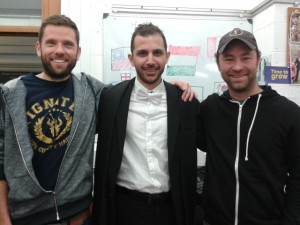
Sozos with Tobias and Geoff
![]()
Wall lizard meeting in Lund
Old and new collaborators – from Australia, England, Italy, France, Germany, Spain and Portugal – came to Lund for two days 16th – 17th of November to share their results, ideas and future research plans on wall lizards. Everyone’s dedication and enthusiasm made the meeting a real success and discussions continued over drinks long after dinner.
Our different backgrounds, expertise, geographic locations and a willingness to share and discuss work in progress make this a fantastic network to be part of. New ideas emerged, new collaborations formed, and we are happy to see expansion of several ongoing projects, from the evolution of phenotypic polymorphism to the genomics of diversification and local adaptation.
We thank everyone who came a long way, everyone here in Lund, and especially Hanna for organizing it all. We hope to see many of you again already next spring!
Below: Daniele, Nathalie, Stefano and Roberto enjoying some refreshments after a long day at the meeting
Participants of the meeting:
Lund University & University of Oxford: Tobias Uller, Weizhao Yang, Nathalie Feiner, Antonio Cordero, Reinder Radersma, Sozos Michaelides, Hanna Laakkonen, Bea Andersson
University of Tasmania: GeoffWhile, Hannah MacGregor
University of Pavia: Roberto Sacchi
University of Pisa: Marco Zuffi
Natural History Museum of Milan: Stefano Scali
Station d’Ecologie Expérimentale du CNRS: Fabien Aubret
University of Valencia: Pau Carazo
CIBIO: Guillem Perez I de Lanuza, Catarina Pinho, Miguel Carretero (TBC), Daniele Salvi (TBC)
University of Trier: Joscha Beninde
Waddington reading group wrapped up
Brief summary of Waddington reading group by Nathalie Feiner
“Und jedem Anfang wohnt ein Zauber inne…“
Hermann Hesse in Stufen, 1941
„A magic dwells in each beginning…“
Indeed, it does feel kind of special to be part of the ‘early developmental stages’ of the Uller group. We are an assembly of six people with very different (scientific) backgrounds and experiences. All of us moved to Lund earlier this year, and it’s therefore a fresh start for all of us in many different ways. Our diverse fields of expertise (from biogeography, life history evolution, and genomics of adaptation to classical embryology) are of course the strength of our group, but it also requires a certain ‘tuning-in’ phase and communication across diverse research areas needs some practice.
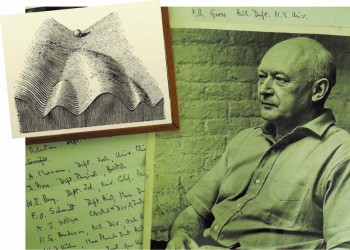 We decided that a reading group would provide us with an informal occasion to get the group going, and to discuss our ideas of how we think evolution actually works. We chose Conrad Hal Waddington’s ‘The Strategy of the Gene’ from 1957 for several reasons. One is that Waddington’s book tries very much the same that we are trying with our research right now, more than 50 years later, namely the synthesis of ecology, development and evolution. By delving into his book, we are aiming to trace back the conceptual origins of our own research agendas. Another reason is Waddington’s focus on epigenetic phenomena. Being very sceptical towards the prevailing neo-Darwinian obsession with assigning absolute control to genes, Waddington was seeking other causal explanations for both development and evolution. It seems like Waddington was sharing very much the same concerns as modern researchers pleading for an extended evolutionary synthesis. Again, this idea is reflected in two of our main lines of research, namely non-genetic inheritance in Daphnia, and phenotypic plasticity in Anolis lizards. Hence, many good reasons to read this book!
We decided that a reading group would provide us with an informal occasion to get the group going, and to discuss our ideas of how we think evolution actually works. We chose Conrad Hal Waddington’s ‘The Strategy of the Gene’ from 1957 for several reasons. One is that Waddington’s book tries very much the same that we are trying with our research right now, more than 50 years later, namely the synthesis of ecology, development and evolution. By delving into his book, we are aiming to trace back the conceptual origins of our own research agendas. Another reason is Waddington’s focus on epigenetic phenomena. Being very sceptical towards the prevailing neo-Darwinian obsession with assigning absolute control to genes, Waddington was seeking other causal explanations for both development and evolution. It seems like Waddington was sharing very much the same concerns as modern researchers pleading for an extended evolutionary synthesis. Again, this idea is reflected in two of our main lines of research, namely non-genetic inheritance in Daphnia, and phenotypic plasticity in Anolis lizards. Hence, many good reasons to read this book!
The reading group was run as follows: we met up on 4 afternoons to discuss each one chapter of the book. We also had Per Lundberg and Pablo Salmon as honorary guests who contributed interesting viewpoints to the discussion. To get accustomed to Swedish culture, we adopted the local rite of having ‘fika’ (=eating lots of sweets) during the meetings. One person took the lead in outlining the major arguments per chapter, and additional literature was consulted, mostly to get a feeling for how Waddington has been interpreted by the scientific community (see WaddingtonReadingGroup).
In summary, I think we can safely conclude that the reading group was a fruitful exercise and that we can all learn from each other. At least the heavy usage of the blackboard suggests that we exchanged a lot of ideas and thoughts and it was surely a nice way a getting to know each other a little bit better.
I hope this was not the last reading group – suggestions for other books are highly welcome!
Sexual selection drives asymmetric introgression in wall lizards
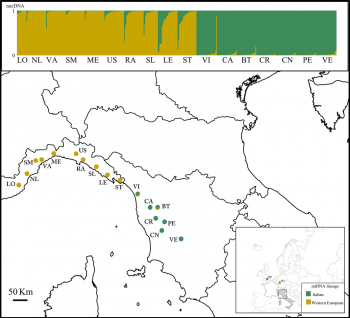 A new paper in Ecology Letters show that allopatric divergence under sexual selection can create asymmetric introgression upon secondary contact. This does not only demonstrate that sexual selection is an important driver of hybridization, but also raises interesting questions about how sexual characters can be transferred from one lineage to another.
A new paper in Ecology Letters show that allopatric divergence under sexual selection can create asymmetric introgression upon secondary contact. This does not only demonstrate that sexual selection is an important driver of hybridization, but also raises interesting questions about how sexual characters can be transferred from one lineage to another.
This paper is a collaborative effort between ourselves and teams throughout Europe who have contributed samples or genetic data to allow us to test how well predictions from experimental enclosures hold up in the wild.
Read the paper here.

